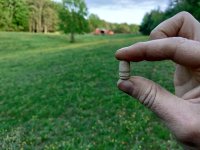Gypsy Heart
Gold Member
Newburyport’s ‘Holy Grail’ keeps its secrets hidden
Published: April 22, 2007 11:35 pm
Centuries later, Newburyport’s ‘Holy Grail’ keeps its secrets hidden
John Macone, Editor
It was 1977, and on the bulldozed and scattered remains of the city’s historic waterfront, archaeologists were just a lucky turn of the spade away from the Holy Grail of Newburyport archaeological sites.
In a city filled with spectacular architecture, the long-buried and elusive ruin the diggers sought to uncover would probably be unimpressive to the casual observer. Only sorry remnants like rusty bits of metal, broken bottles and pottery and a pile of stones were likely to have survived the centuries.
But for archaeologists like Alaric Faulkner, the site was a potential gold mine.
For years archaeologists and amateur historians have been piecing together clues to the location of “Watt’s Cellar,” owned by an English trader the Indians dubbed “Great Walt” or “Great Watt.”
No one knows exactly where the cellar was, what it looked like, or even what it was used for. There has been plenty of speculation on all of those questions.
The only thing that anyone can say for sure about it is this: It is the very first documentable structure built by a European colonist in what is now Newburyport. In fact, it’s believed to be the first colonist-built structure in the entire Merrimack River valley.
And its importance is still felt today. If it weren’t for Watt’s Cellar, downtown Newburyport might not be located where it is.
The hunt for Great Watt’s Cellar lasted several weeks during the summer of 1977, extending around the Firehouse Center for the Arts and selected spots closer to the riverbank.
It didn’t yield the city’s Holy Grail, but it did reveal some unexpected glimpses into Newburyport’s past, Faulkner said.
The hunt
The dig was one of the fruits of a lawsuit brought by Friends of the Newburyport Waterfront. That lengthy legal battle over the waterfront’s development will be explored more fully in future installments of the Port in Progress series.
Watt’s Cellar was certainly a plum that archaeologists hoped to pick, but it wasn’t the only objective of the dig. Faulkner said extensive remains of Indian settlements were thought to exist, as well as the remnants of 17th, 18th and 19th century waterfront buildings.
Archaeologists knew that Indians had some type of village where downtown Newburyport is now. Clams, mussels and other shellfish were important to their diet, and heaps of shells are often found near their coastal settlements. A sizeable shell heap had been found under The Daily News building on Liberty Street.
Faulkner, a soon-to-be-retired professor of anthropology at the University of Maine, vividly remembers the details of the dig.
In 1977 the land around and behind the Firehouse, he recalled, was an unattractive mess. Most of Newburyport’s waterfront buildings between the Custom House and the Black Cow restaurant had been recently torn down during the early stages of urban renewal. What remained were small heaps of rubble, dusty open ground and cellarholes filled with debris — including broken TV sets. There was no visible trace of Watt’s cellar.
“The chances of finding it were slim,” Faulkner said.
Archaeologists faced another problem: Urban renewal was well underway around Market Square, so places where they fervently hoped to dig had already been paved over with bricks or built on.
“When we came in they had just rebuilt the building where Bossy Gillis’ garage had stood,” Faulkner said. “It would have been nice to do it the other way around.”
But the diggable area between the Firehouse and Custom House was part of the hub of Newburyport’s early seaport, and Faulkner said more than 20,000 artifacts were recovered, as well as the remains of several buildings and wharves.
The waterfront had a handful of fine homes, but generally it was a tough neighborhood. Along the downtown riverbanks stood gritty shipyards, docks, warehouses, stores and tenements. Rats and other vermin were common, noted Jay Williamson, director of the Historical Society of Old Newbury.
Faulkner said artifacts confirmed many of the waterfront’s stereotypes but also gave a glimpse into some of its more refined aspects.
For instance, 19th century ink wells, slate pencils and small ceramics marked “good boy” and “good girl” were found. Based in part on 19th century census reports, historians had long considered the waterfront populated by illiterate immigrants. But the evidence suggested there was a culture of literacy and learning, Faulkner said.
“It tells us more about the people who were taking the census than the immigrants who were living there,” he said.
Among the richest archaeological discoveries were the privies — the outhouses into which colonists often dumped their trash.
The privies demonstrated Newburyporters had “fantastic access to foreign goods,” Faulkner said.
Among the items recovered were ceramics with political slogans, including one that declared, “Success to the King of Prussia and his forces.”
That slogan referred to the Seven Years War, known in America as the French and Indian War. By default, Prussia was the colonists’ ally because it was fighting against France during the conflict of the 1750s and ‘60s. A decade or so later, during the American Revolution, their roles would be reversed — Prussians were fighting as mercenaries against the Americans, and the French were providing arms, supplies and troops to George Washington’s army.
No Indian village was found, Faulkner said. Archaeologists unearthed five arrowheads.
No Watt
The archaeologists may have found some remnants of Great Watt’s Cellar, but Faulkner said they can’t be certain.
Pieces of English pottery dating to the early 1600s were discovered in centuries-old backfill, but Faulkner thinks it’s likely that the cellar itself may no longer exist — it was probably destroyed two centuries ago, when the Middle Shipyard was active on that site.
All that remains is a historic marker next to the Firehouse Center for the Arts noting that Watt’s Cellar was “near this spot.”
That cellar’s significance is still palpable today.
Watt had picked a good spot for his trading post, near a rocky point that provided handy access to the river.
Almost 30 years after Watt disappeared, another trader — Paul White — built a dock and a handful of buildings using that same rock outcropping. Over the years, more buildings sprung up near White’s compound. One hundred years later, the site had grown into the core of downtown Newburyport.
The cellar itself must have been visible in those early days, because it is referred to in several early deeds. Those deeds help pinpoint its location near Market Square.
Among those early deeds are references to a main road the colonists called “Way to Watt’s Cellar.” The name of that road changed a handful of times since then.
The road is still there, but Watt would never recognize it. It’s State Street.
Jay Williamson,(pictured below) curator of the Cushing House Museum, displays artifacts found in the downtown area during urban renewal. Students found the pieces while searching for “Watt’s Cellar” in 1977.
Published: April 22, 2007 11:35 pm
Centuries later, Newburyport’s ‘Holy Grail’ keeps its secrets hidden
John Macone, Editor
It was 1977, and on the bulldozed and scattered remains of the city’s historic waterfront, archaeologists were just a lucky turn of the spade away from the Holy Grail of Newburyport archaeological sites.
In a city filled with spectacular architecture, the long-buried and elusive ruin the diggers sought to uncover would probably be unimpressive to the casual observer. Only sorry remnants like rusty bits of metal, broken bottles and pottery and a pile of stones were likely to have survived the centuries.
But for archaeologists like Alaric Faulkner, the site was a potential gold mine.
For years archaeologists and amateur historians have been piecing together clues to the location of “Watt’s Cellar,” owned by an English trader the Indians dubbed “Great Walt” or “Great Watt.”
No one knows exactly where the cellar was, what it looked like, or even what it was used for. There has been plenty of speculation on all of those questions.
The only thing that anyone can say for sure about it is this: It is the very first documentable structure built by a European colonist in what is now Newburyport. In fact, it’s believed to be the first colonist-built structure in the entire Merrimack River valley.
And its importance is still felt today. If it weren’t for Watt’s Cellar, downtown Newburyport might not be located where it is.
The hunt for Great Watt’s Cellar lasted several weeks during the summer of 1977, extending around the Firehouse Center for the Arts and selected spots closer to the riverbank.
It didn’t yield the city’s Holy Grail, but it did reveal some unexpected glimpses into Newburyport’s past, Faulkner said.
The hunt
The dig was one of the fruits of a lawsuit brought by Friends of the Newburyport Waterfront. That lengthy legal battle over the waterfront’s development will be explored more fully in future installments of the Port in Progress series.
Watt’s Cellar was certainly a plum that archaeologists hoped to pick, but it wasn’t the only objective of the dig. Faulkner said extensive remains of Indian settlements were thought to exist, as well as the remnants of 17th, 18th and 19th century waterfront buildings.
Archaeologists knew that Indians had some type of village where downtown Newburyport is now. Clams, mussels and other shellfish were important to their diet, and heaps of shells are often found near their coastal settlements. A sizeable shell heap had been found under The Daily News building on Liberty Street.
Faulkner, a soon-to-be-retired professor of anthropology at the University of Maine, vividly remembers the details of the dig.
In 1977 the land around and behind the Firehouse, he recalled, was an unattractive mess. Most of Newburyport’s waterfront buildings between the Custom House and the Black Cow restaurant had been recently torn down during the early stages of urban renewal. What remained were small heaps of rubble, dusty open ground and cellarholes filled with debris — including broken TV sets. There was no visible trace of Watt’s cellar.
“The chances of finding it were slim,” Faulkner said.
Archaeologists faced another problem: Urban renewal was well underway around Market Square, so places where they fervently hoped to dig had already been paved over with bricks or built on.
“When we came in they had just rebuilt the building where Bossy Gillis’ garage had stood,” Faulkner said. “It would have been nice to do it the other way around.”
But the diggable area between the Firehouse and Custom House was part of the hub of Newburyport’s early seaport, and Faulkner said more than 20,000 artifacts were recovered, as well as the remains of several buildings and wharves.
The waterfront had a handful of fine homes, but generally it was a tough neighborhood. Along the downtown riverbanks stood gritty shipyards, docks, warehouses, stores and tenements. Rats and other vermin were common, noted Jay Williamson, director of the Historical Society of Old Newbury.
Faulkner said artifacts confirmed many of the waterfront’s stereotypes but also gave a glimpse into some of its more refined aspects.
For instance, 19th century ink wells, slate pencils and small ceramics marked “good boy” and “good girl” were found. Based in part on 19th century census reports, historians had long considered the waterfront populated by illiterate immigrants. But the evidence suggested there was a culture of literacy and learning, Faulkner said.
“It tells us more about the people who were taking the census than the immigrants who were living there,” he said.
Among the richest archaeological discoveries were the privies — the outhouses into which colonists often dumped their trash.
The privies demonstrated Newburyporters had “fantastic access to foreign goods,” Faulkner said.
Among the items recovered were ceramics with political slogans, including one that declared, “Success to the King of Prussia and his forces.”
That slogan referred to the Seven Years War, known in America as the French and Indian War. By default, Prussia was the colonists’ ally because it was fighting against France during the conflict of the 1750s and ‘60s. A decade or so later, during the American Revolution, their roles would be reversed — Prussians were fighting as mercenaries against the Americans, and the French were providing arms, supplies and troops to George Washington’s army.
No Indian village was found, Faulkner said. Archaeologists unearthed five arrowheads.
No Watt
The archaeologists may have found some remnants of Great Watt’s Cellar, but Faulkner said they can’t be certain.
Pieces of English pottery dating to the early 1600s were discovered in centuries-old backfill, but Faulkner thinks it’s likely that the cellar itself may no longer exist — it was probably destroyed two centuries ago, when the Middle Shipyard was active on that site.
All that remains is a historic marker next to the Firehouse Center for the Arts noting that Watt’s Cellar was “near this spot.”
That cellar’s significance is still palpable today.
Watt had picked a good spot for his trading post, near a rocky point that provided handy access to the river.
Almost 30 years after Watt disappeared, another trader — Paul White — built a dock and a handful of buildings using that same rock outcropping. Over the years, more buildings sprung up near White’s compound. One hundred years later, the site had grown into the core of downtown Newburyport.
The cellar itself must have been visible in those early days, because it is referred to in several early deeds. Those deeds help pinpoint its location near Market Square.
Among those early deeds are references to a main road the colonists called “Way to Watt’s Cellar.” The name of that road changed a handful of times since then.
The road is still there, but Watt would never recognize it. It’s State Street.
Jay Williamson,(pictured below) curator of the Cushing House Museum, displays artifacts found in the downtown area during urban renewal. Students found the pieces while searching for “Watt’s Cellar” in 1977.
Attachments
Upvote
0




